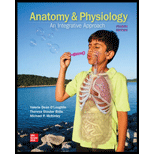
ANATOMY+PHYSIOLOGY-CONNECT ACCESS
4th Edition
ISBN: 9781264265398
Author: McKinley
Publisher: MCG
expand_more
expand_more
format_list_bulleted
Concept explainers
Question
Chapter 27, Problem 13DYKB
Summary Introduction
To distinguish:
In-between non-essential and essential amino acids.
Concept introduction:
The amino acids are building blocks of macromolecules proteins. There are twenty amino acids required to make proteins in all organisms. These proteins participate in the
Expert Solution & Answer
Want to see the full answer?
Check out a sample textbook solution
Students have asked these similar questions
What is the structure and function of Eukaryotic cells, including their organelles? How are Eukaryotic cells different than Prokaryotic cells, in terms of evolution which form of the cell might have came first? How do Eukaryotic cells become malignant (cancerous)?
What are the roles of DNA and proteins inside of the cell? What are the building blocks or molecular components of the DNA and proteins? How are proteins produced within the cell? What connection is there between DNA, proteins, and the cell cycle? What is the relationship between DNA, proteins, and Cancer?
Why cells go through various types of cell division and how eukaryotic cells control cell growth through the cell cycle control system?
Chapter 27 Solutions
ANATOMY+PHYSIOLOGY-CONNECT ACCESS
Ch. 27.1 - List the six nutrients required by the body.Ch. 27.1 - Prob. 2WDYLCh. 27.1 - Prob. 3WDYLCh. 27.2 - Prob. 4WDYLCh. 27.2 - Prob. 5WDYLCh. 27.2 - Prob. 6WDYLCh. 27.2 - Prob. 7WDYLCh. 27.2 - How may a vegetarian obtain all of the essential...Ch. 27.3 - Prob. 9WDYLCh. 27.3 - What are the major minerals? The trace minerals?...
Ch. 27.4 - What categories of food are shown on the USDA...Ch. 27.4 - What is the purpose of the requirement for...Ch. 27.5 - Prob. 13WDYLCh. 27.5 - Prob. 14WDYLCh. 27.6 - Prob. 15WDYLCh. 27.6 - Prob. 16WDYLCh. 27.6 - Prob. 17WDYLCh. 27.6 - Prob. 18WDYLCh. 27.7 - Where in the biochemical pathway of cellular...Ch. 27.7 - How is excess sugar (glucose) converted to fat...Ch. 27.8 - Prob. 21WDYLCh. 27.8 - Prob. 22WDYLCh. 27.8 - Prob. 23WDYLCh. 27 - _____ 1. Which of the following is a nutrient? a....Ch. 27 - Prob. 2DYKBCh. 27 - _____ 3. What is the major macronutrient in a...Ch. 27 - _____ 4. During the absorptive state a. blood...Ch. 27 - _____ 5. When the pancreas releases insulin, it...Ch. 27 - Prob. 6DYKBCh. 27 - _____ 7. Which of the following conditions is not...Ch. 27 - _____ 8. Total metabolic rate increases under...Ch. 27 - _____ 9. All of the following are functions of the...Ch. 27 - Prob. 10DYKBCh. 27 - Define nutrition.Ch. 27 - Prob. 12DYKBCh. 27 - Prob. 13DYKBCh. 27 - Prob. 14DYKBCh. 27 - Define minerals, and give examples of their...Ch. 27 - Define nitrogen balance, and compare positive...Ch. 27 - Define the postabsorptive state. What is the major...Ch. 27 - Explain the function of the liver in the transport...Ch. 27 - Prob. 19DYKBCh. 27 - Prob. 20DYKBCh. 27 - An individual has recently adopted a vegetarian...Ch. 27 - Prob. 2CALCh. 27 - Prob. 3CALCh. 27 - Prob. 4CALCh. 27 - Prob. 5CALCh. 27 - Prob. 1CSLCh. 27 - Prob. 2CSLCh. 27 - Prob. 3CSL
Knowledge Booster
Learn more about
Need a deep-dive on the concept behind this application? Look no further. Learn more about this topic, biology and related others by exploring similar questions and additional content below.Similar questions
- In one paragraph show how atoms and they're structure are related to the structure of dna and proteins. Talk about what atoms are. what they're made of, why chemical bonding is important to DNA?arrow_forwardWhat are the structure and properties of atoms and chemical bonds (especially how they relate to DNA and proteins).arrow_forwardThe Sentinel Cell: Nature’s Answer to Cancer?arrow_forward
- Molecular Biology Question You are working to characterize a novel protein in mice. Analysis shows that high levels of the primary transcript that codes for this protein are found in tissue from the brain, muscle, liver, and pancreas. However, an antibody that recognizes the C-terminal portion of the protein indicates that the protein is present in brain, muscle, and liver, but not in the pancreas. What is the most likely explanation for this result?arrow_forwardMolecular Biology Explain/discuss how “slow stop” and “quick/fast stop” mutants wereused to identify different protein involved in DNA replication in E. coli.arrow_forwardMolecular Biology Question A gene that codes for a protein was removed from a eukaryotic cell and inserted into a prokaryotic cell. Although the gene was successfully transcribed and translated, it produced a different protein than it produced in the eukaryotic cell. What is the most likely explanation?arrow_forward
- Molecular Biology LIST three characteristics of origins of replicationarrow_forwardMolecular Biology Question Please help. Thank you For E coli DNA polymerase III, give the structure and function of the b-clamp sub-complex. Describe how the structure of this sub-complex is important for it’s function.arrow_forwardMolecular Biology LIST three characteristics of DNA Polymerasesarrow_forward
arrow_back_ios
SEE MORE QUESTIONS
arrow_forward_ios
Recommended textbooks for you
- Lifetime Physical Fitness & WellnessHealth & NutritionISBN:9781337677509Author:HOEGERPublisher:Cengage
 Biology (MindTap Course List)BiologyISBN:9781337392938Author:Eldra Solomon, Charles Martin, Diana W. Martin, Linda R. BergPublisher:Cengage Learning
Biology (MindTap Course List)BiologyISBN:9781337392938Author:Eldra Solomon, Charles Martin, Diana W. Martin, Linda R. BergPublisher:Cengage Learning Human Biology (MindTap Course List)BiologyISBN:9781305112100Author:Cecie Starr, Beverly McMillanPublisher:Cengage Learning
Human Biology (MindTap Course List)BiologyISBN:9781305112100Author:Cecie Starr, Beverly McMillanPublisher:Cengage Learning




Lifetime Physical Fitness & Wellness
Health & Nutrition
ISBN:9781337677509
Author:HOEGER
Publisher:Cengage

Biology (MindTap Course List)
Biology
ISBN:9781337392938
Author:Eldra Solomon, Charles Martin, Diana W. Martin, Linda R. Berg
Publisher:Cengage Learning

Human Biology (MindTap Course List)
Biology
ISBN:9781305112100
Author:Cecie Starr, Beverly McMillan
Publisher:Cengage Learning